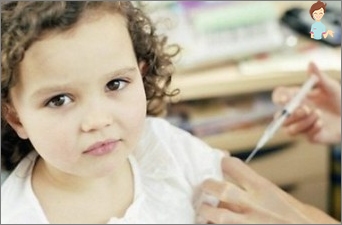What vaccinations need to do children?
Why make vaccinations to children? What diseases protects vaccination? What and at what age the child vaccinated? Graph vaccinations
Tuberculosis, rubella, diphtheria, tetanus, cortex, polio, cough, vapotitis, hepatitis B – diseases that are listed in the vaccination chart for children. Using such simple methods, you can protect the body from the most common and dangerous diseases and infections.
 Thanks to the measures taken, he will receive artificial immunity to the disease, which will save him both from the disease itself and from its consequences.
Thanks to the measures taken, he will receive artificial immunity to the disease, which will save him both from the disease itself and from its consequences.
It is necessary to strictly observe the timing of vaccination and revaccination. The graph of preventive vaccinations with newborns and senior children is drawn up with the risk of morbidity, age and health, education of immunity.
For example, immunity to measles is produced immediately after the first vaccination, and to protect against polio, it is necessary to repeat the procedure for three months.
The first vaccinations get back in the maternity hospital in the first day of life. Immediately vaccinated from hepatitis B, and after 3-4 days – from tuberculosis.
Calendar vaccinations
- 12 hours after the baby was born, the first vaccine is introduced – from hepatitis B;
- From 3 to 7 day they are vaccinated from tuberculosis (BCG);
- In 1 month, the second vaccination against hepatitis B;
- At the age of 3 months, a combined vaccine is administered immediately from several diseases: diphtheria, polio pertussis and tetanus. They are broken into two vaccinations – the first includes a vaccine from three diseases, and from polyomelitis is administered separately;
- In 4 months, the above-described manipulations are repeated;
- When the baby was half a year, it is again vaccinated by combined vaccinations, but includes hepatitis B;
- Upon reaching 1 year, a combined drug is administered immediately from three diseases: rubella, measles and vapotitis;
- The next time the doctor must be visited within a year and a half, when the calendar is planned revaccination from polio, diphtheria, cough, tetanus;
- In 20 months, repeated from poliomyelitis;
- The next vaccination the child will receive only 6 years. This time also use a combined drug. A similar vaccine has received a child in a year;
- At the age of 7 years, the first revaccination against tuberculosis and the second from the tetanus and diphtheria (ADS) are carried out;
- At the age of 13, vaccinations make selectively, for example, if the child did not receive vaccines from hepatitis, I introduce them. It is worth noting that at this age they make graving from rubella, but only girls;
- In a year, that is, at the reaches of 14 years, it is carried out revaccination from polio, tetanus and diphtheria, as well as tuberculosis.
At this vaccination calendar for children ends, but it is worth mentioning that adults should conduct revaccinations from tetanus and diphtheria every ten years.
Newborn and older children who are sick and restored after the disease do not vaccinate. After the procedure, the kid leads a normal lifestyle, however, parents must observe. In the event of an increase in temperature or the appearance of other ailments, you must consult a doctor.
Vaccination calendar provides vaccinations from the following diseases:
 Tuberculosis – infectious bacterial disease that affects mostly lungs;
Tuberculosis – infectious bacterial disease that affects mostly lungs;- Hepatitis B – infectious viral disease affecting the liver. In some cases, it develops into a chronic form and causes cirrhosis of the liver;
- Poliomyelitis – acute infection caused by a virus. Leads to paresis and paralymps;
- Diphtheria – bacterial infection, affecting the respiratory tract, heart, kidneys, nervous system and other organs. Prior to the introduction of mandatory vaccination, this disease in most cases led to a fatal outcome;
- Cocalus – acute bacterial infection, characterized by an approached cough;
- Tetannik – infectious disease caused by bacteria. Strikes the central nervous system, causes convulsions and asphyxia;
- Cort – viral disease characterized by a rash and an increase in lymph nodes. It is dangerous in the first trimesters of pregnancy, as it may not be bad to influence the normal process of developing a child up to vices and even miscarriage;
- Parotitis – viral infection that affects salivary glands and nervous system. Special danger is present for boys, as it can affect the testicles and lead to infertility.
Mantu Mantu Sample Graph for Children
Mantu reaction – the main preventive method of examination for tuberculosis. Sample allows you to determine the presence of a disease in the body.
Annual examination with the help of inside the skin sample Mantu is subject to children, starting from the age of 1 year, and adolescents. Allowed only healthy kids. Planned manta is carried out regularly, despite the reaction from the previous sample.
When entering tuberculin (substance that is used to determine the presence of the disease), swelling is formed in the upper layer, peculiar «Butt». It is very important to correctly care for this place, because forbidden manipulations may affect the result. It is impossible to smear it with peroxide, green and other antiseptics.
It is important to prevent the contact of this place with water or other liquid. Also, you should not stick the wield of the plaster or close by other methods. It is impossible to comb. When the doctor evaluates the result, then the wound, if an ulcer was formed on it, you can process, like any other skin lesion using all traditional means.
What can affect the reaction of Mantu?
- Allergic dermatitis, food, drug allergies;
- Recently transferred infections;
- Chronic pathology;
- Immunity to netuberculosis mycobacteriums;
- Age;
- Sensitivity of the skin;
- Phase of the menstrual cycle (in female);
- Balanced diet;
- Worms;
- Increased radiation background in the area of residence;
- Harmful emissions of chemical industries;
- Individual intolerance of tuberculina;
- Violations of the methodology of testing: inconsistent transportation, storage, non-standard or poor-quality inventory, error in the technique of performing and reading the reaction.
 Before any vaccination or revaccination, you need to visit the doctor who examines the child and give permission to conduct manipulations.
Before any vaccination or revaccination, you need to visit the doctor who examines the child and give permission to conduct manipulations.
Now the practice of abandoning, although it is not justified. In any case, the vaccinated body is able to disgrace the disease and even if the kid picks up one or another infection, it will flow in a light form and will not give complications. In addition, using preventive vaccinations, you can stop the epidemic and even prevent this phenomenon.
Make a decision regarding the feasibility of vaccinations for a child may exclusively parent. However, dear parents, before making such a decision, weigh all «per» and «against»!


